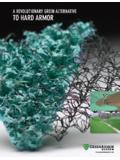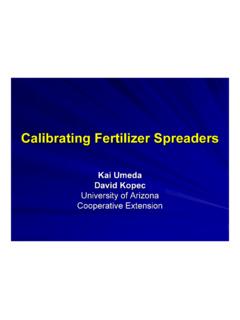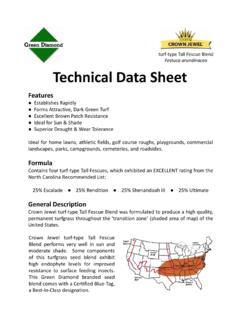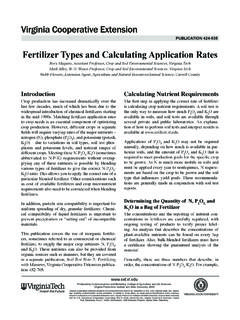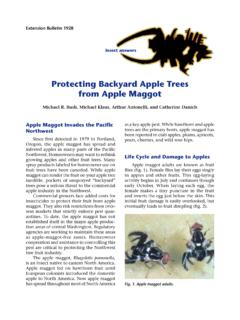Transcription of What you need to know about . . . Reading a …
1 Co l l e g e o f Ag r i C u l t u rA l SC i e n C e S Ag r i C u l t u rA l re S e A r C h A n d Co o p e rA t i v e ex t e nS i o npe S t i C i d e ed u C A t i o n pr o g rA mReading a Pesticide LabelWhat you need to know about ..Why are labels important?Labels are legal documents providing directions on how to mix, apply, store, and dispose of a pesticide label is the manufacturer s main way to give the user information about the product . SelectingApplyingMixingStoringDisposingA lways remember toread the label when ..What information does the front of the label contain?
2 Brand NameDifferent names are used by different manufacturers even though their products contain the same active ingredients. The brand name (or trade or product name) is a unique name used to advertise the TypeListed under the brand name, this indicates in general terms what the product will control. Here are two examples: herbicide for the control of woody brush and weeds, and insecticide for control of certain insects on fruits, nuts, and Registration NumberIndicates that the pesticide product has been registered and its label was approved for sale by the Environmental Protection Agency (EPA).
3 EPA Establishment NumberIdentifies the facility that produced the Name and AddressProvides the manufacturer s contact information in case you want more information about the product , such as a Material Safety Data Sheet (MSDS) that provides detailed toxicity information, chemical properties, and precautions needed for emergency StatementProvides the common and/or chemical name and amount of each active ingredient and the total amount of inert ingredients in the IngredientThe chemical(s) responsible for controlling the pest. Individually listed on the label by common name and/or chemical name and percentage in the NameThe complex name identifying the chemical components and structure of a NameA simpler name given by the EPA to a chemical name for easier IngredientsNot required to be individually listed, but their percent of content must ContentsThe amount a full container WordsSignal words indicate the relative acute toxicity of the product to humans and animals.
4 The statement KEEP OUT OF THE REACH OF CHILDREN must also appear above the signal word on the label. If two products will control the same pest, signal words can help you choose the least toxic chemical to control the POISON Highly toxic by any route of entry into the body. Peligro, the Spanish word for danger, must also appear on the label. Pesticides with this signal word are classified as restricted use and can only be purchased and applied by a certified pesticide NgER Can cause severe eye damage or skin Moderately toxic either orally, dermally, or through inhalation; causes moderate eye or skin irritation.
5 Aviso, the Spanish word for warning, must also appear on the ION Slightly toxic either orally, dermally, or through inhalation; causes slight eye or skin other information can be found on the label?Precautionary StatementsInformation about possible hazards. Additional information can be found in the to Humans and Domestic AnimalsDescribes the potential hazards to people and pets, and actions you can take to reduce those hazards, for example, wearing gloves. These statements may also provide extra information on how to protect children and HazardsDescribes the product s potential to harm wildlife, fish, endangered plants and animals, wetlands, or and Chemical HazardsDescribes any special fire, explosion, or chemical hazards the product may Aid or Statement of Practical TreatmentDetails what to do if someone is accidentally poisoned by a pesticide.
6 ALWAYS call the National Poison Center Hotline (1-800-222-1222) for further medical instructions. Since the label has specific instructions and information the physician will need, it is important to have the pesticide label available when calling the hotline or when taking someone to the out of Reach of childRenDANgER POI sONPeligroPrepared by Richard H. Johnson Jr., extension associate; Sharon I. Gripp, database administrator/Webmaster; and Kerry M. Richards, acting director, Penn State Pesticide Education Penn State s College of Agricultural Sciences on the Web: State College of Agricultural Sciences research, extension, and resident education programs are funded in part by Pennsylvania counties, the Commonwealth of Pennsylvania, and the Department of publication is available from the Publications Distribution Center, The Pennsylvania State University, 112 Agricultural Administration Building, University Park, PA 16802.
7 For information telephone publication is available in alternative media on Pennsylvania State University is committed to the policy that all persons shall have equal access to programs, facilities, admission, and employment without regard to personal characteristics not related to ability, performance, or qualifications as determined by University policy or by state or federal authorities. It is the policy of the University to maintain an academic and work environment free of discrimination, including harassment. The Pennsylvania State University prohibits discrimination and harassment against any person because of age, ancestry, color, disability or handicap, national origin, race, religious creed, sex, sexual orientation, gender identity, or veteran status.
8 Discrimination or harassment against faculty, staff, or students will not be tolerated at The Pennsylvania State University. Direct all inquiries regarding the nondiscrimination policy to the Affirmative Action Director, The Pennsylvania State University, 328 Boucke Building, University Park, PA 16802-5901; Tel 814-865-4700/V, 814-863-1150/TTY. The Pennsylvania State University 2009 Produced by Ag Communications and MarketingCODE # uO215 Rev11M09/09payne4579 This publication is also available in for useIt is a violation of federal law to use any pesticide in a manner inconsistent with its labeling.
9 This section tells you how to properly use a product to get the best results without harming yourself, others, and the environment. The label s directions for use will tell you: What pests the product is registered to control Where the product can be used (plants, animals, locations) How to apply the product How much product to use When the product should be applied How often to apply the product How soon the crop can be used or eaten after an application When people and animals can re-enter a treated area after applicationMake sure the product is labeled for use against the pest(s) that you are trying to control.
10 (For example, a product labeled only for termites may not be labeled to control fleas.) Also, make sure the product is only used where (plants, animals, locations) the label indicates. (For example, a pesticide labeled for use in an azalea bed may not be labeled for use in an annual flower bed.) Use only the amounts recommended, and follow the directions and DisposalExplains how to best store the product and what to do with the unused portion of the product and the empty container. Always keep products in original containers, out of the reach of children, and in a locked storage area.
